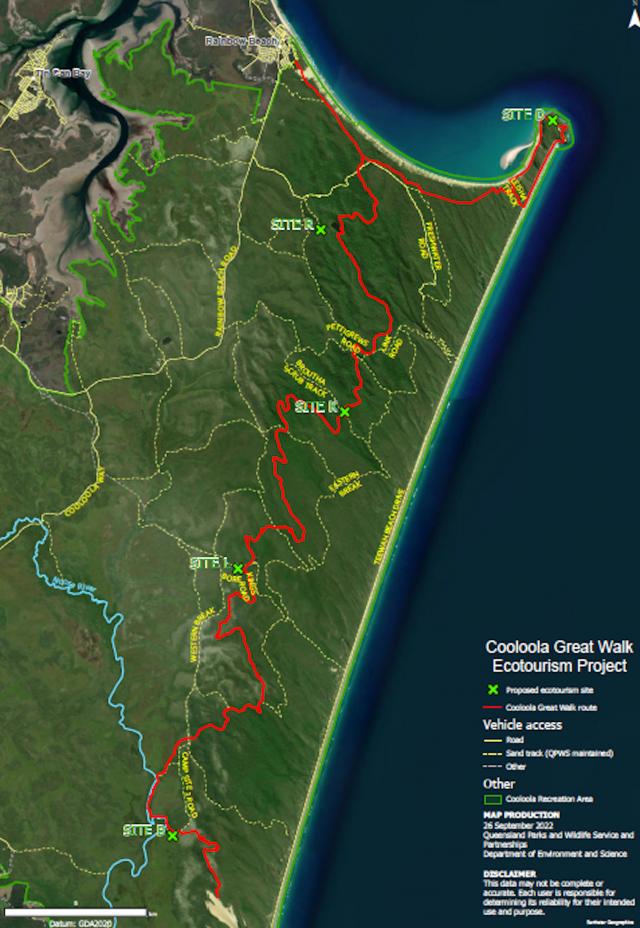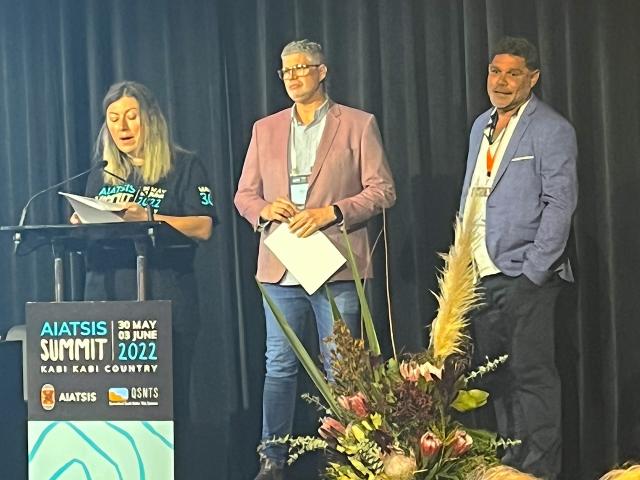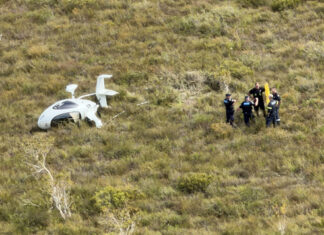The Queensland Government and Kabi Kabi First Nations representatives have reached an important agreement on the placement of campsites within the proposed Cooloola Great Walk ecotourism project ahead of a vote on an Indigenous Land Use Agreement next month.
The plan to move controversial sites away from the environmentally sensitive Lake Poona and Upper Noosa River wetlands was revealed last week in a government newsletter and immediately praised by Noosa Parks Association as “environmentally responsible”.
Notice of two meetings which will determine the future of the controversial project was also announced, albeit tucked away in the public notice pages of the First Nations-targeted Koori Mail and the mainstream Courier-Mail newspapers and websites in their respective editions of 5 and 8 October, and has attracted very little media attention since.
But for the Cooloola Great Walk Ecotourism Project, the meetings to discuss and vote on an Indigenous Land Use Agreement (ILUA), will be the signal turning point in a multi-faceted battle between friends and foe, and variations within that equation, that has raged on and off for three years or more.
It seems we may have reached the stage of this interminable row, where it must be asked, is this the end of the beginning or the beginning of the end?
The fine detail of the public notice revealed more about the actual process being followed than we had been allowed to see, at least until the Queensland Government media machine started rolling out explanatory frequently asked questions on websites and social media platforms a few days later.
After many months of silence hidden behind the curtains of commercial in confidence and the like, the cards are now on the table.
The Kabi Kabi First Nation Traditional Owners will meet in Gympie on Saturday 5 November to consider the authorisation of an ILUA covering a large area of the Cooloola section of the Great Sandy National Park which would permit “the grant of a lease or leases … for ecotourism-related infrastructure including cabins, communal facilities, access tracks”, whether to enter into commercial agreements with the tourism project operator, and whether to enter into a Cultural Heritage Management Agreement.
A week after the consultation and briefing, on Saturday 12 November, the Kabi Kabi Traditional Owners will meet in Gympie again to vote on the issues. And this is where the future of a project that has divided the environmental lobby and First Nations, as well as the broader community, will be determined.
If the ILUA is rejected, the Cooloola Great Walk Ecotourism Project goes away. If it gets the vote – and the smart money is on this outcome, albeit by a slim majority – the project proceeds to the next phase of negotiation of commercial agreements with the operator, the South Australia-based CABN company, which has not played a part in the preparation for the ILUA vote.
Put simply, a yes vote in Gympie next month by no means guarantees that the glamping project will go ahead, but it would definitely signal the end of the beginning.
And in their preparation for the vote, the Kabi Kabi and government working teams seem to have done their research and fieldwork in clearing obstacles in the minefield of environmental concerns. No matter how much work they did, the philosophical argument (known as the cardinal principle, and already lost in many parts of Australia), that there is no place for private enterprise in our national parks, was always going to remain.
But the specific issues of potential environmental damage at two of the five original camp sites along the Great Walk appear to have been addressed.
A newsletter published by the Department of Tourism, Innovation and Sport’s Queensland Ecotourism Trails division on 12 October spelled out the updated proposed project sites:
“Traditional Owners the Kabi Kabi Peoples have given notice of a private Traditional Owner community meeting to be held on 5 November to consider the proposed ecotourism accommodation sites for the Cooloola Great Walk ecotourism project.
“This best-practice environmental and cultural ecotourism experience aims to establish five small-scale, low-impact ecotourism facilities and activities along the Great Walk, enhancing the walking experience through simple accommodation and guided tours, making it more accessible to a wider range of visitors.
“Following public feedback, independent ecological advice and project stakeholder consultation, two sites are proposed to be relocated to alternative sites along the route.
“These are:
– “Banksia (or Site B) is located outside of the flooding inundation zone of the Noosa River, off an existing vehicle access track and approximately 400m east of the Noosa River. The proposed Site B avoids significant wetland values, in particular the Cooloola Patterned Fens, avoids potential fauna habitat, mature koala habitat and hollow bearing trees, and is close to the Cooloola Great Walk and existing vehicle access.
– “Ridgeline (Site R) is entirely outside of Poona Lake’s catchment near the existing QPWS communication tower, approximately 400 metres west of Poona Lake. Site R is located in previously disturbed (ex-forestry) blackbutt woodland, away from high value rainforest and undisturbed old-growth blackbutt, and requires no additional vehicle access track to be constructed.”
The newsletter concluded: “Native Title holders, the Kabi Kabi people, will present the proposed changes at their community meeting. If accepted, the authorisation of an Indigenous Land Use Agreement and Cultural Heritage Management Plan will follow.”
The announcement of the new sites certainly got the attention of Noosa Parks Association, which has been a long-term supporter of the project but a recent critic of its possible encroachment on Noosa River wetlands and Lake Poona.
Vice President Michael Gloster told Noosa Today: “NPA congratulates the project partners on the choice of new sites at Banksia and Ridgeline. NPA publicly supports them as environmentally responsible.”
Websites and social media are now overflowing with further information on the latest developments in the Cooloola Great Walk in the form of FAQ responses, many of them attempting to allay fears in some quarters that this project is much bigger than has been revealed thus far, but until the ILUA vote next month the newsletter quoted above provides the most concise information seen since the somewhat confusing Kabi/CABN presentation at the Australian Institute of Aboriginal and Torres Strait Islanders Studies summit at Twin Waters back in June.
As Noosa Today reported then: “A presentation on Mabo Day last week should have been a celebration of a project that has the potential to become our greatest example of Native Title in action.
“Instead many people left the room scratching their heads about the future of the Cooloola Great Walk, and wondering whether beautiful Poona Lake would be closed to walkers.”
For those who have followed this project closely, there should be less head scratching going on today, but the question of public access at major attractions on the walk, Double Island Point and Lake Poona, is still a grey area – the latest Department of Environment and Science output said, “All publicly accessible existing public campsites, walking tracks and recreation areas will remain open”, while the Kabi Kabi public notice says the ILUA would permit “consideration of applications to restrict public access at Double Island Point and Lake Poona.” (It should be noted here that restricted access areas can have designated public walking tracks within them.)
DES also noted in its new information that actual site plans and structures are still in development for a project now scheduled for completion in early 2024.
So, how far have we really travelled down the Cooloola Great Walk?
Noosa Parks Association VP Michael Gloster believes the site moves have answered questions of environmental responsibility, but now it’s up to the Kabi Kabi.
He said: “To date Noosa Parks Association has been lobbying to ensure that Cooloola National Park’s natural values and iconic landscapes are not degraded by the proposed Cooloola Great Walk.
“More than any other party, NPA has led the creation and progressive extension of Cooloola National Park over the past 60 years, so we have skin in the game.
“NPA is delighted that the project partners have scrapped proposed Great Walk sites next to Lake Poona and the Upper Noosa River and replaced them with the new and environmentally responsible Ridgeline and Banksia sites.
“NPA thanks the project partners for listening to its advocacy, and thanks the Member for Noosa, Sandy Bolton, for her tireless work behind the scenes helping responsible site choice.
“NPA supports increased Kabi Kabi people’s ownership and management of National Parks in the Noosa-Cooloola region and supports Kabi Kabi people now deciding whether or not the proposed Cooloola Great Walk should proceed.
“If it proceeds, NPA will be lobbying for Cooloola Great Walk contractual arrangements between the State, CABN and Kabi Kabi peoples that deliver improved environmental and management outcomes for Cooloola National Park.”
Ms Bolton told a community meeting in Pomona on 5 October: “Having travelled this journey now for over two years, I am supportive of endeavours from our Kabi Kabi, and our community on environmental concerns.
“We have seen much progress in working towards an outcome that is better environmentally, as well in developing understanding in the needs of our First Nations people to create their future.”
After the release of the new site locations Ms Bolton told Noosa Today: “Everyone I’ve spoken to so far thinks these are much better sites, but I haven’t had full responses yet from [environmental] advocates.
“They are now well away from the areas of environmental concern, and Cultural Heritage are re-checking the new sites to make sure they measure up from that perspective.
“This process, even with consultation coming under criticism, has shown that our community has been listened to and we have better outcomes as a result, however, I’m still waiting to see the finer details as we go through the various processes still to come should Kabi Kabi vote to proceed.”
If the ILUA vote next month green-lights the ecotourism project, one of those processes among the many, will be development applications to Gympie and Noosa Councils for the constructions proposed for each site.
And with the opponents of the project still to be heard in full on the latest developments, who knows what else may be in store?








